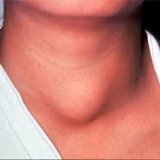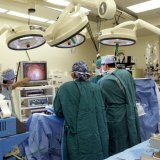Case Report: Thyroid Cancer
 This disease can be called a disaster of our time. In recent years, the incidence of thyroid cancer has increased significantly, and it is increasingly manifested in people younger than 30 years. So, the case history: thyroid cancer is the topic of the conversation for today.
This disease can be called a disaster of our time. In recent years, the incidence of thyroid cancer has increased significantly, and it is increasingly manifested in people younger than 30 years. So, the case history: thyroid cancer is the topic of the conversation for today.
Types of thyroid cancer
This disease is divided into two groups, depending on whether it originates from the follicular epithelium or from parafollicular cells. In the latter case( with medullary thyroid cancer), there are a number of characteristic physiological and clinical features that require special attention and urgent medical intervention.
The clinical course of the three different histological types of cancer varies. The most common type of cancer is anaplastic cancer. It is always very malignant and resistant to radiation, it usually affects the elderly. Death of the patient occurs quickly due to local growth of the tumor. The second type of cancer is follicular cancer. It occurs infrequently and resembles normal thyroid tissue from the histological side. He early begins to metastasize by hematogenous way, and patients can have metastases already at the first reference to the doctor. Most often, metastases arise in the lungs and bones. The third and most frequent form of cancer is tumors of the papillary cancer. He has a bimodal age distribution - appears in the second-third decade and then in old age. Such tumors grow slowly and metastasize more often to regional lymph nodes. At any time, an exacerbation of the disease may occur.
Symptoms of thyroid cancer
Suspected cancer can occur with a fresh growth of the thyroid node, especially if it is not accompanied by tissue softening and changes in voice. Special attention is required by those patients who in the past had information about exposure to radiation of the head, upper mediastinum or neck, since this process is associated with a high incidence of thyroid pathology in the future. The case history of each patient is checked, and if there were exposures in childhood, this patient is given special attention. Approximately 20% of such individuals develop nodes in the thyroid gland. Until their appearance can take many years( 30 or more).
An experienced specialist can diagnose cancer of the gland simply by palpating it. A node that is surrounded by a normal thyroid tissue should cause more suspicion of a tumor than each of several palpable nodes. The latter can be part of a diffuse process, in the manner of simple goiter. In addition, usually the cancer is characterized by a dense consistency without softening. Age and sex of the patient are also important for the recognition of thyroid cancer. Women are more likely to have benign nodes than men. This is less typical of malignant neoplasms, which is why nodal formations in men are more dangerous than in women.
Patient management and ongoing procedures
The doctor should immediately decide whether to continue monitoring the patient by administering to him suppressive doses of thyroid hormones or to abandon it. Hormones can reduce or completely cure suspicious nodes( this, however, rarely happens).You can still wait for the results of a puncture biopsy or an open biopsy and thyroidectomy. Typically, doctors choose the latter approach.
It is especially important to conduct the correct set of procedures for people who have undergone in the past thyroid irradiation or those who have one or more palpable nodes. In the zone of special attention are young men and women with solitary knots, especially dense ones, which do not contain softened areas and which are rapidly increasing in size. In some cases, aspiration or incisional puncture biopsy is recommended. The first procedure is simple and does not give complications. It provides optimal results where there is a possibility of histopathological examination of the samples obtained. Despite possible false positive and negative results, this technique reduces the number of patients undergoing surgery.
Thyroid Cancer Treatment
Surgical intervention for thyroid cancer should always be performed by an experienced surgeon in the field. To facilitate the ongoing operation and reduce the risk of tumor dissemination, a few weeks before surgery, the patient should be prescribed suppressive therapy with levothyroxine. If, however, the patient did not have a definitive diagnosis before the operation( for example, a biopsy was not performed), a suspicious formation should be removed along with a large area of surrounding tissue.
Concerning the type of intervention in the detection of thyroid disease, the opinions of doctors differ. Some experts recommend that ipsilateral lobectomy, removal of the isthmus and, possibly, a partial contralateral lobectomy. Although the frequency of complications is high, many doctors still prefer to produce total thyroidectomy.
Regional lymph nodes are examined and removed, but radical removal of cervical tissues is not necessary. If the cancer was detected not with an urgent biopsy( in the study of the frozen cut), and with the systematic study of the sections, a repeated operation is carried out to remove the remaining thyroid tissue.
Patients are re-examined about six months after the operation, and then the examinations are repeated at least twice a year. During the examination, the neck is palpated to reveal relapse or the appearance of metastases, which can be surgically removed. Blood samples are taken to determine thyroglobulin, since its elevated concentration in the patient indicates the presence of metastases.
Postoperative period
At the first examination, six months after the operation, the entire body is scanned. Patients who did not have metastases in the previous scan were not subjected to repeated irradiation. It is carried out only 1 year after the removal of the tumor.
Adaptive postoperative program includes almost total thyroidectomy, suppressive therapy and destruction of metastases by radioiodine. This can significantly reduce the frequency of relapses and prolong the life of a patient with papillary thyroid cancer. Patients with follicular cancer undergo treatment equally( if not more) intensively and radically, although the results are less favorable. In anaplastic cancer, palliative measures are generally applicable - most such patients die within six months after diagnosis.



